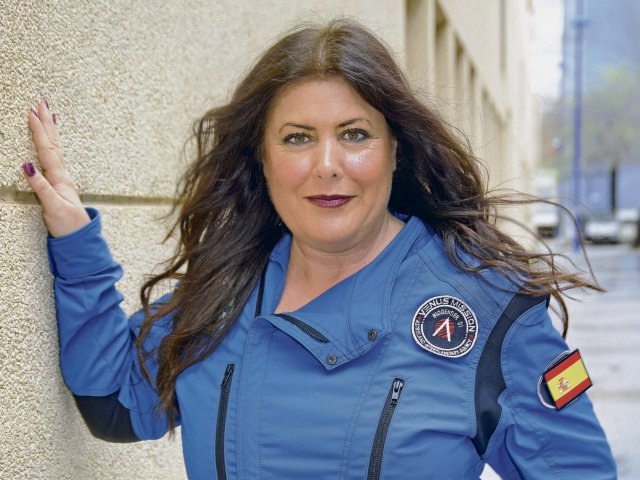Foto: Monica Gumm
Ms. Torres, have you always had the dream of becoming astronaut?
I have always fascinated space, as well as aviation. At the age of five I said I wanted to be astronaut. My parents just laughed and said: “You never manage that!” Later, when I wanted to be a pilot, it was said: “Women cannot be pilots!” So I first became a flight attendant – until I acquired my pilot license in parallel. Today I fight against age discrimination. I am often told that I am “too old” for certain things. But as long as body and mind work, experience is a valuable asset!
You are analog astronaut. How do you become?
There are three ways into this profession: as a scientist, as an astronaut candidate or – as in my case – as a pilot. I actually studied journalism and communication, but I have completed additional training in engineering, astrobiology and astrophysics. I also intensively prepared myself mentally and physically for these special missions.
Interview
Mariló Torres Soto53 years old, works both in the public service in Córdoba and as an analog astronaut in simulated space missions on earth. She is a trained pilot.
What exactly do you do on analog missions?
In analog missions, we simulate the extreme conditions of moon, Mars or room stations in specially selected terrestrial environments. Both natural places such as volcanoes and deserts as well as artificial habitats such as isolated bunkers serve as test environments. As subjects, we collect valuable data about human behavior and technology under space conditions. The highlight: By provoking errors in a safe environment, we identify risks that are supposed to avoid real astronauts in space.
Which extraordinary places did you work?
So far I was involved in four missions: two took place in Spain, in an underground cave near Santander in Cantabria at the research station of the private space company Astroland. The other two led me to a NASA facility in Hawaii and last year to Poland to the Lunares research station, an underground bunker under a former Soviet military airport.
What does you mentally deal with when you enter such a habitat?
The most important thing – and the first thing the psychologists appreciates – is total immersion in experience. That means I fully concentrate on flying to the moon or Mars. Above all, I am preparing that it will be a difficult, strict, extreme experience. And that my personal needs or fears are secondary.
Do you take a personal object to the mission?
We can’t take anything with us. Many things are forbidden, such as cosmetics or your own clothing. Everything is provided by the space station. This is not a place to think of the figure or banal things. But many years ago, a French astronaut gave me a screw that traveled in the Ariane rocket. It is my talisman. For me, this screw is like a connection to space.
How does such a journey come to the “earthly all”?
It is an extremely intensive experience. The missions usually last one to two weeks, sometimes even months. Every minute is clocked- sleep and meal times are strictly limited. Apart from the weightlessness that we cannot simulate, we live exactly like astronauts: with the same restrictions, routines, emergency procedures and protocols. We wear heavy spatial suits that can weigh up to 20 kilograms. The food is freezing and we cannot take a shower – only washing with special cloths. All of this serves to make our experiments as realistically as possible.
What is part of your personal preparation for the simulations?
In my case, I was able to fall back on my experience as a pilot, since many space procedures are derived from aviation. I also speak Russian and English, which is essential in this area. I have a staff trainer for strength training. My mental training in self -control, resilience, psychological stress and relaxation is also very important. But the best preparation is actually already completed missions. My first mission 2022 in Spain was a jump into the cold water, but you learn a lot about yourself and your limits – which are often further than you think.
How many people work together?
Usually a crew consists of five to eight people from all over the world with a wide variety of backgrounds. There is almost always a doctor who monitors the health of the crew and can intervene in an emergency.
Would you actually want to fly into space?
That would be my absolute dream! Even if I knew I wouldn’t return – I would go without hesitation. There are currently only two realistic ways: either you are a billionaire and can afford a flight to companies like Blue Origin or you go through the years of selection process of a spacecraft agency. Pablo Álvarez, who recently been the first Spaniard by the ESA for 30 years, is a great role model for this.
What is the most unpleasant about the missions?
The lack of real showers is certainly a point, as is the heavy equipment that is physically extremely exhausting. The constant lack of sleep and mental exhaustion are added. But of course I know what I’m getting into and accept it.
How does the return to the normal world feel?
It is as if you came out of a protected room from an amniotic sac. On the one hand, I am sad to end this experience and, on the other hand, make it easier to live a comfortable life again. I always need a few days to find your way back to everyday life and process the experience.
The neighboring Sevilla is to become a hub for space technology. What can you contribute to this?
I am in discussions with the Spanish space agency. She would like to encourage scientists to use my upcoming mission at Mars Society in Utah (USA) as a platform for research projects. I see it as my job to promote this promising cooperation between science and applied space research.
nd.kompact – our daily newsletter

Our daily newsletter nd. compact Bring order to the news madness. You get an overview of the most exciting stories from the Editorial team. Get the free subscription here.
What would you want to give people on earth?
Three things are particularly important to me: First, as a society, we should develop more awareness of the importance of manned space travel and provide appropriate resources. Second, I would like to convey the fascination for this field – many people don’t even know what is possible. And thirdly, I particularly care about inspiring girls for MINT professions. When I attend schools, I see the enthusiasm and openness with the girls.
What are your next projects?
If everything works, in July it goes to Brazil to the “Alpha Centauri” mission in Habitat Marte, the only South American Mars analog habitat. And at the end of 2025 or early 2026 there is a mission with Mars Society in the Utah desert in the USA. My big dream of course remains the flight into space – as a professional astronaut.
link sbobet judi bola online sbobet88 judi bola
